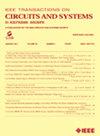一种支持深度神经网络低延迟推理的40 TOPS单芯片加速器
IF 4.9
2区 工程技术
Q2 ENGINEERING, ELECTRICAL & ELECTRONIC
IEEE Transactions on Circuits and Systems II: Express Briefs
Pub Date : 2025-04-21
DOI:10.1109/TCSII.2025.3563062
引用次数: 0
摘要
为了实现边缘应用的低延迟,提出了一种单芯片稀疏加速器,该加速器可以在有限的片上内存下进行深度神经网络(DNN)推理。消除了私有内存,所有内存都是共享的,以减少功耗和芯片面积。提出了一种用于存储稀疏dnn的自适应变长压缩算法。提出了一种弱约束剪枝算法来解决内核级的负载平衡问题,该算法可以获得与无约束剪枝方案(UCP)几乎相同的稀疏性。在此基础上,采用8256个mac和9.4 MB片上SRAM,在28纳米CMOS上制作了一个低延迟推理加速器,YOLO3微处理器的延迟可达到0.44 ms。对于高稀疏层,我们的芯片可以实现6.1倍的加速和40 TOPS的吞吐量。使用修剪的YOLO模型,我们的加速器实现了比Jetson Orin低6.7倍的延迟和21.7倍的能效。建立了一个高速评估平台,用于演示每秒600帧(fps)的实时目标检测,功率为1.34 W。本文章由计算机程序翻译,如有差异,请以英文原文为准。
A 40 TOPS Single-Chip Accelerator Enabling Low-Latency Inference for Deep Neural Networks
To achieve low latency for edge applications, a single-chip sparse accelerator is proposed, which can conduct deep neural network (DNN) inference only using limited on-chip memory. Private memory is eliminated, and all memories are shared to reduce power and chip area. An adaptive and variable-length compression algorithm is proposed to store sparse DNNs. A weak-constrained pruning algorithm is proposed to resolve load balance issue in kernel level, which can achieve almost the same sparsity as unconstrained pruning schemes (UCP). Based on these works, a low latency inference accelerator is fabricated in 28-nm CMOS with 8256 MACs and 9.4 MB on-chip SRAM, which can achieve a latency of 0.44 ms for YOLO3 tiny. For high-sparsity layers, our chip can achieve $6.1\times $ speedup and a throughput of 40 TOPS. With a pruned YOLO model, our accelerator achieves $6.7\times $ lower latency and $21.7\times $ better energy efficiency than Jetson Orin. A high-speed evaluation platform is built to demonstrate real-time object detection at a throughput of 600 frames per second (fps) with a power of 1.34 W.
求助全文
通过发布文献求助,成功后即可免费获取论文全文。
去求助
来源期刊
CiteScore
7.90
自引率
20.50%
发文量
883
审稿时长
3.0 months
期刊介绍:
TCAS II publishes brief papers in the field specified by the theory, analysis, design, and practical implementations of circuits, and the application of circuit techniques to systems and to signal processing. Included is the whole spectrum from basic scientific theory to industrial applications. The field of interest covered includes:
Circuits: Analog, Digital and Mixed Signal Circuits and Systems
Nonlinear Circuits and Systems, Integrated Sensors, MEMS and Systems on Chip, Nanoscale Circuits and Systems, Optoelectronic
Circuits and Systems, Power Electronics and Systems
Software for Analog-and-Logic Circuits and Systems
Control aspects of Circuits and Systems.

 求助内容:
求助内容: 应助结果提醒方式:
应助结果提醒方式:


